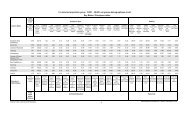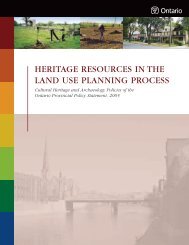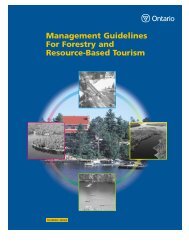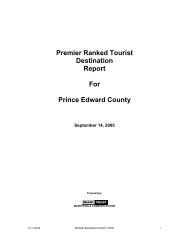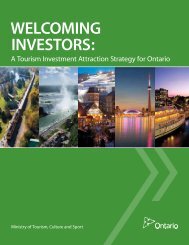Factors Influencing Visitor's Choices of Urban Destinations in North ...
Factors Influencing Visitor's Choices of Urban Destinations in North ...
Factors Influencing Visitor's Choices of Urban Destinations in North ...
Create successful ePaper yourself
Turn your PDF publications into a flip-book with our unique Google optimized e-Paper software.
• The cost <strong>of</strong> liv<strong>in</strong>g for tourists <strong>in</strong> the dest<strong>in</strong>ation country relative to the cost <strong>of</strong>liv<strong>in</strong>g for tourists <strong>in</strong> the United K<strong>in</strong>gdom (proxied by the consumer price <strong>in</strong>dexadjusted by the exchange rate with the orig<strong>in</strong> country);• The cost <strong>of</strong> liv<strong>in</strong>g for tourists <strong>in</strong> the dest<strong>in</strong>ation country relative to a weightedaverage <strong>of</strong> the cost <strong>of</strong> liv<strong>in</strong>g <strong>in</strong> n<strong>in</strong>e other compet<strong>in</strong>g foreign dest<strong>in</strong>ations;• Real standard air fare from the United K<strong>in</strong>gdom to the dest<strong>in</strong>ation country; and• The airfare from the United K<strong>in</strong>gdom to the dest<strong>in</strong>ation relative to a weightedaverage <strong>of</strong> airfares to compet<strong>in</strong>g foreign dest<strong>in</strong>ations.Seasonal dummies were also <strong>in</strong>cluded <strong>in</strong> the model to capture seasonal fluctuations <strong>of</strong> thedependent variable.The authors concluded that future studies should pay more attention to recentdevelopments <strong>in</strong> econometric theory <strong>in</strong> construct<strong>in</strong>g tourism demand models.“Why People Travel to Different Places”Papatheodorou (2001) <strong>in</strong>dicates the importance <strong>of</strong> <strong>in</strong>clud<strong>in</strong>g supply side factors such asproduct differentiation and corporate power exercised by tourism product providers <strong>in</strong>demand models. Accord<strong>in</strong>g to Papatheodorou, traditional demand theory, as it is utilized<strong>in</strong> most exist<strong>in</strong>g tourism demand models, is not sufficient to expla<strong>in</strong> the direction <strong>of</strong>tourism flows. He notes several drawbacks <strong>of</strong> us<strong>in</strong>g tourism demand systems to forecastthe market shares <strong>of</strong> dest<strong>in</strong>ations:The assumption <strong>of</strong> a representative tourist is highly unrealistic given a heterogeneitynature <strong>of</strong> a specific leisure tourist or group <strong>of</strong> tourists.The static nature <strong>of</strong> the traditional demand theory cannot account for the evolutionaryfeatures <strong>of</strong> the tourism product (i.e. appearance <strong>of</strong> new resorts). It is also important todifferentiate one tourism product from the other (i.e. Greek tourism product is differentfrom Mexican or Ch<strong>in</strong>ese product).Third, the traditional demand theory can only work with<strong>in</strong> a competitive environmentwhere the producers act as price takers who cannot manipulate tourists to accept higherprices for a tourism product. In reality, however, the trend towards global consolidationbetween tourism product providers creates opportunities for oligopoly. The establishment<strong>of</strong> oligopolistic power <strong>in</strong> the market is detrimental to a consumer.“Forecast<strong>in</strong>g Tourist Arrivals”Lim and McAleer (2001) used various exponential smooth<strong>in</strong>g models to forecastquarterly tourist arrivals to Australia from Hong Kong, Malaysia, and S<strong>in</strong>gapore. Themodels were estimated over the period <strong>of</strong> 1975-99 us<strong>in</strong>g quarterly data. One-quarterahead <strong>in</strong>ternational tourism forecasts for the period 1998(1)-2000(1) were evaluated <strong>in</strong>terms <strong>of</strong> the forecast<strong>in</strong>g accuracy us<strong>in</strong>g root mean squared error criterion (RMSE).Models: The exponential smooth<strong>in</strong>g models tested <strong>in</strong>clude the s<strong>in</strong>gle-equation models asfollows: the Holt-W<strong>in</strong>ters additive and multiplicative seasonal models, s<strong>in</strong>gle, double,and the Holt-W<strong>in</strong>ters non-seasonal exponential smooth<strong>in</strong>g models.56


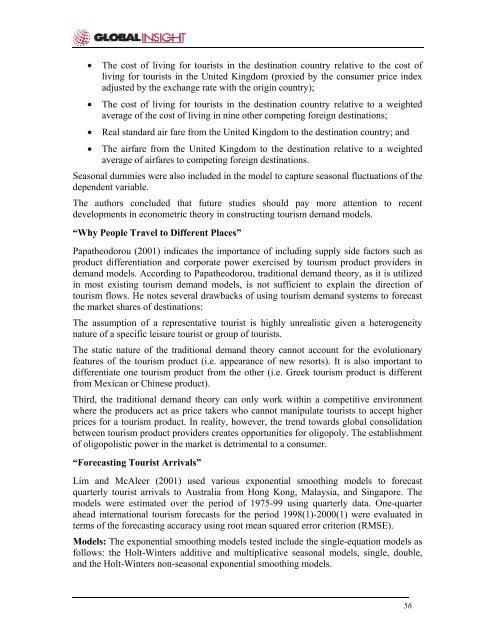
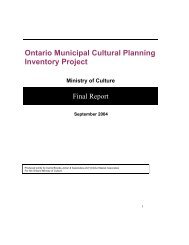
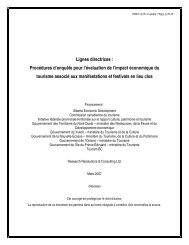
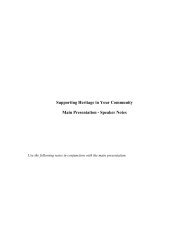
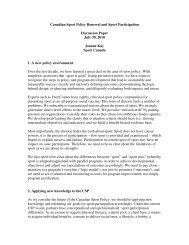
![THIS AGREEMENT made this [date], between [name of owner] (the ...](https://img.yumpu.com/49827605/1/158x260/this-agreement-made-this-date-between-name-of-owner-the-.jpg?quality=85)

